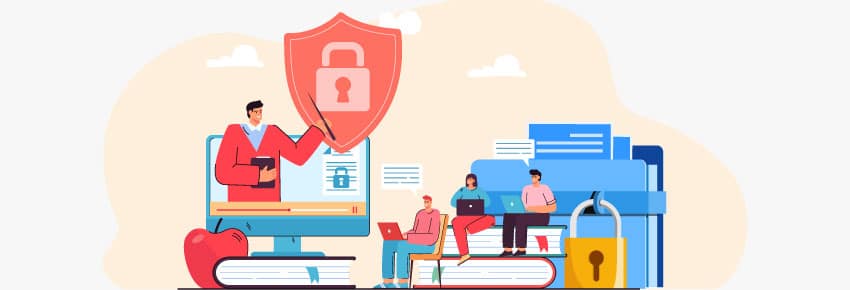A Crisis Looms for Data Privacy In Remote Learning
Abr 12, 2021 | 42Gears Team

Data privacy in remote learning hasn’t been a major concern for many during the pandemic, out of sheer necessity. In many circumstances, there simply wasn’t any alternative to remote learning – and this meant that few were in the position to object and back out if their data was unsafe.
As global populations finally begin to receive vaccinations, remote learning will no longer be so widespread, and millions of students will begin to return to physical classrooms. Once remote classrooms become a thing of the past, students can finally afford to ask if their data was safe during the months they attended class from afar.
For many schools, this won’t be a major concern. If administrators took the time to properly protect student data during the pandemic, student queries aren’t a problem. On the other hand, if schools have been negligent or invasive regarding data privacy in remote learning, the next few months will prove to be a big challenge.
In any case, now is the time for students, teachers, and administrators to understand whether data remained safe for remote learning. Let’s first review how this issue manifests in students’ lives, before turning to the way administrators should proceed. At that point, it will be clear how to fix privacy issues going forward.
Why is Data Privacy in Remote Learning a Major Issue?
Students may feel like they need to tolerate invasions of privacy while learning remotely. This sentiment is no longer true once students meet again in person. At that point, students will begin to reflect on the ways in which their schools did not respect their privacy.
As you may know, one of the most invasive forms of student tracking is test-proctoring software, such as Proctorio. Such software claims to deter cheating by tracking student movements via webcam, but has many downsides. For one, it traps the test-taker in front of a webcam, with periodic scans to confirm the student is behaving. School teachers can look at recordings of students to see if someone is cheating. Of course, there are many reasons why someone might need to look away from a computer while taking a test at home. This can be humiliating or anxiety-inducing for students who have to take exams in chaotic or unstable homes.
Another major concern for student privacy concerns the collection and sale of student activity data to schools by third-parties. For instance, Gaggle monitors all student activity on both school-related and personal accounts to detect and stop potential violent offenders ahead of time.
To make matters worse, students who have been sent home with school-owned devices may be subject to spyware. Schools may be tempted to download spyware to computers so that admins can ensure students aren’t abusing school-owned devices. However, this is illegal and a grave violation of student privacy. In fact, this can be catastrophic for the offending school district.
Even if schools are not intentionally using these kinds of programs, it is possible to fall victim to malware. Ransomware attacks can shut down school districts overnight; if the jeopardized data contains unsecured student data, the consequences can be disastrous.
How Can Anyone Take Control of Data Privacy in Remote Learning?
Of course, an important starting point for teachers and administrators is to stop mandating the use of potentially invasive software. On top of the concerns mentioned above, this kind of software is not very effective in preventing cheating behavior. This means there’s no real incentive to use it, or at least, none that outweighs its risks and downsides.
It’s also essential that schools do not put spyware on loaned computers. Any on-board software should be disclosed immediately to students and parents. At that point, they can decide whether they are comfortable with a particular manner of using the device.
An alternative method of restricting school-owned devices is to employ mobile device management software, also known as MDM software. This allows admins to restrict what students can do on a laptop or other device prior to loaning a student the device. Of course, administrators must properly explain the software to students in advance. Once they do, they can restrict what activities students can do on a laptop without continual monitoring. Plus, mobile device management software also helps to protect school devices from malware attacks.
Finally, students and administrators alike should take the time to read their schools’ data protection and student rights documentation. If monitoring software violates this documentation, students can refuse to use it, and admins will know that they need to change it immediately. A good resource for healthy data practices is the guidelines Stanford University asks its affiliates to follow. If your institution has not implemented something of this caliber, it should do so as soon as possible.
Conclusion
Transitioning from remote learning back to in-person learning is not easy one for many reasons. This is thanks in large part to a more critical attitude towards data privacy in remote learning. For its part, 42Gears offers mobile device management software to install on devices admins provide to students. As long as it is in compliance with local laws and regulations, and agreed-upon by students beforehand, mobile device management software can resolve many of the issues tied to spyware, proctoring software, and other controversial measures.
Responsibly manage school-owned devices with 42Gears
Subscribe for our free newsletter
